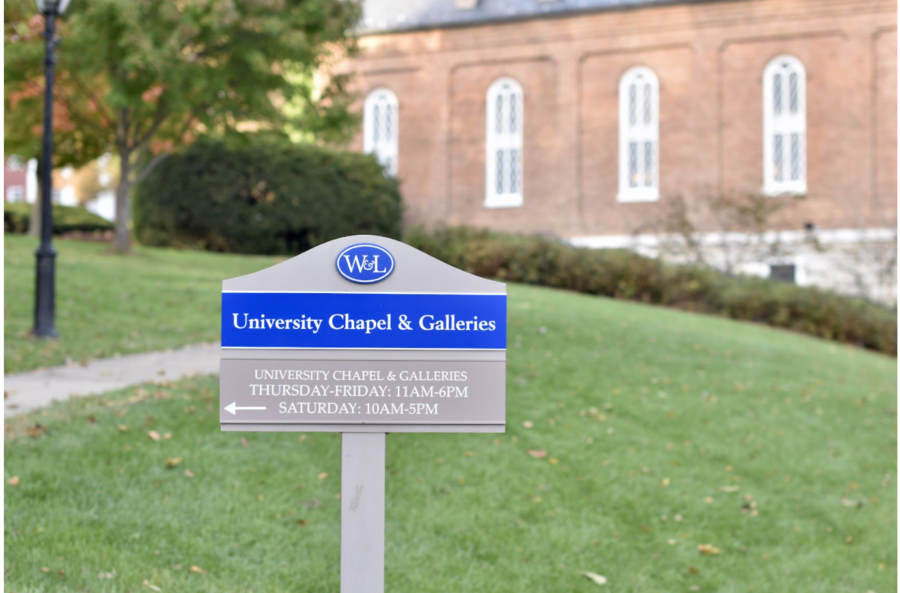Students and tourists want transparency about changes happening within the newly-renamed University Chapel
Despite months of alterations, no updates have been provided on the memorials removed from the chapel
The chapel is open to students and visitors who are interested in learning about institutional history. Photo by Liliah Kimble, ’23.
November 9, 2021
On June 4, 2021, the Board of Trustees voted 22-6 to retain the name of Washington and Lee University, but to rename “Lee Chapel” to “University Chapel.”
The trustees also declared that “interior changes” would be made to restore the chapel’s “unadorned design and [to] physically separate the auditorium from the Lee family crypt and Lee memorial sculpture.”
The Ring-tum Phi covered the chapel name change during the summer, capturing mixed reactions from students and community members.
But now, students are responding to the interior changes occurring within the chapel.
Professor Lynn Rainville, who was hired in 2019 as the inaugural director of Institutional History and the Museums, manages University Chapel.
Last week, she said, about two-thirds of the plaques within the auditorium space of the chapel had been removed. The rest of the plaques will be removed later this term.
The museums “are targeting summer of 2022 for the completion of the chapel modifications,” such as the walling-off of the Recumbent Lee statue, Rainville said.
Not everyone supports these changes.
Margaret Alexander, ’24, vice-president of Students for Historical Preservation, believes that the board’s decision on June 4 sends mixed signals on what the university values.
“They keep Lee in the university name, but not at his final resting place,” Alexander said.
Alexander said she worries that interior changes within University Chapel compromise its “historical integrity.” She said she never saw the chapel last year, and with two-thirds of the plaques gone, she does not think she will ever have an opportunity to learn about them.
Alexander specifically referenced the United Daughters of the Confederacy (UDC), an organization she understands held a large role in the preservation of the chapel’s history.
Recently, a UDC inscription on the steps of the chapel’s upper stage was covered up.
“It is important to learn…the UDC’s role in promoting Lost Cause history,” she said.
Alexander believes that stripping away the name of the UDC prevents students from ever learning about them. Rainville declined to comment on the status and plans for the UDC engraving.
A Virginian tourist, Buck Burwell Jr., said this removal of memorials is “intellectual cowardice.” He lamented the “destruction of something so wonderful…and educational.”
Burwell said he had not heard about the summer announcement. But he said that during prior visits he enjoyed the portraits of Washington and Lee in the chapel sanctuary, which were removed this year.
Some students, like JC Ward, ’23, think the chapel space “should be as welcoming as possible to all students” on campus.
“Separating the Lee memorial sculpture from the auditorium is a perfectly acceptable action,” Ward said.
But Ward said that these plans should be reasonably transparent.
“Every single interior change made to the chapel does not need to be sent in a university-wide email, but certainly if someone would like to access the information about the changes being done they should have access to that information and about the broader plan,” Ward said.
The Liberty Hall Volunteers memorial plaque, a large marble tablet that lists the original roll of Company I of the Fourth Virginia Infantry (most of whom attended then-Washington College), was also removed from University Chapel.
Some arguing for the removal of the tablet agreed that the university should publicize the memorial’s condition and future plans.
“Regardless of where the Liberty Hall Volunteers plaque is located, its whereabouts should be made aware to those interested in institutional history,” Ward said.
Alexander said transparency is needed about all chapel renovations.
“I’m a little disheartened that not much has been made public,” she said.
According to Rainville, the final location for the removed plaques will be decided after renovations of the chapel are completed.
“Once the separation between the auditorium and the galleries is achieved, we will decide whether the plaques can be installed in future gallery space or whether they will become part of the new museum of institutional history,” Rainville said.
Rainville said there is not a current timeline for the new museum




Harry Ballance • Dec 9, 2021 at 9:46 am
This is somewhat analogous to the Taliban destroying the Buddhist statues in Afghanistan. If these “woke” professors and students were so fill of revulsion and distaste – to include the good Dr. Dudley – for the University, its culture and traditions, why did they choose to be there? If W&L’s character is changed, all that would be left is a small college in the hinterlands of America. The Trustees need to get a grip on this, remove Dudley, and move to restore W&L to the institution it was for over one hundred years.
Harry Ballance 1962
John Duncan • Dec 8, 2021 at 5:51 pm
Just stop giving money to an now historical farce, Washington & Lee University. There are good schools that can use your contribution.
John Duncan
Scott Bell • Nov 10, 2021 at 12:48 pm
I had the privilege of visiting Lee Chapel before wokeness cancel culture and political correctness took over. There would not be a university if not for General Lee. So wrong and sad that history is being destroyed there.
Gordon • Nov 10, 2021 at 9:25 am
This is shameful. General Lee saved Washington College from bankruptcy and the administration spits on his grave. The college is not welcoming to the Sons of those who followed him into battle and protected the Commonwealth during an hour of grave peril. President Dudley should resign. Eventually, the wokesters and snowflakes will come for him. No one would attend a college named Washington and Lee except to cause trouble.
Andrew Pearson • Nov 10, 2021 at 9:06 am
Understatement of the decade: “Not everyone supports these changes.”